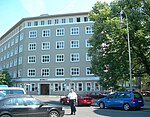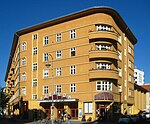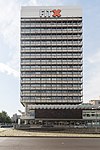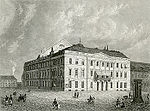Park Inn by Radisson Berlin Alexanderplatz
Buildings and structures in BerlinEmporis template using building IDHotel buildings completed in 1970Hotels in BerlinPark Inn by Radisson ... and 3 more
Rezidor Hotel GroupSkyscraper hotels in GermanySkyscrapers in Berlin

The Park Inn by Radisson Berlin Alexanderplatz is the tallest building and the eleventh-tallest structure in Berlin and the 29th-tallest building and tallest hotel-only building in Germany. The 37-floor high-rise is in the northeast of Alexanderplatz in the central Mitte district and has a height of 125 metres (410 feet).
Excerpt from the Wikipedia article Park Inn by Radisson Berlin Alexanderplatz (License: CC BY-SA 3.0, Authors, Images).Park Inn by Radisson Berlin Alexanderplatz
Berlin Mitte
Geographical coordinates (GPS) Address External links Nearby Places Show on map
Geographical coordinates (GPS)
| Latitude | Longitude |
|---|---|
| N 52.522777777778 ° | E 13.412777777778 ° |
Address
Park Inn by Radisson Berlin-Alexanderplatz
7
10178 Berlin, Mitte
Germany
Open on Google Maps









